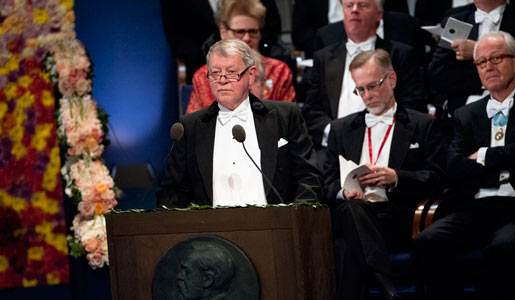Award ceremony speech
English
Presentation Speech by Professor Björn Jonson, Member of the Royal Swedish Academy of Sciences; Chairman of the Nobel Committee for Physics, 10 December 2012

Professor Björn Jonson delivering the Presentation Speech for the 2012 Nobel Prize in Physics at the Stockholm Concert Hall.
Copyright © Nobel Media AB 2012
Photo: Alex Ljungdahl
In his epilogue at the Master’s Degree Celebration in Lund 1820, Professor Esaias Tegnér – also a famous poet and author – said
This is Man’s wonderful ability:
to be able to grasp the inner essence of phenomena,
not what they appear to be, but what they mean,
and the reality that we see with our eyes
is a symbol only of something higher.
What is it that our eyes see? It is light. Everything we see around us – colours, shapes, and objects – comes from light that strikes our eyes, which forwards the information to be analysed by our brain. What we see can be described and understood with what we today call classical physics. But if we try to describe the heart of matter, classical physics is not enough!
Because of this, physicists in the 1920s developed a theory for the innermost parts of matter. It is an extremely beautiful theory called quantum mechanics. In the quantum world, light, atoms, nuclei and elementary particles are all described as being both particles and waves. Quantum physics has been extremely successful in modern physics. But to really observe matter at the quantum level one encounters major problems since almost any attempt to make a measurement causes the quantum properties to simply disappear. It has therefore been a dream since the dawn of quantum physics to be able to study individual quantum systems. This dream has now become a reality.
This year’s Nobel Laureates, together with their research groups, have used cleverly designed experiments to successfully perform the trick of controlling and measuring single isolated quantum systems without destroying their quantum properties. Serge Haroche and David Wineland have opened the door to the observation of the most fundamental quantum world. In the laboratory, they have shown that it is possible to perform tricks according to the rules of quantum physics that were previously not thought possible. They have shown how to study and control and count quantum systems. One may call this mastering without touching – since the enchantment of the micro-world would otherwise disappear.
Their experimental methods have many things in common. David Wineland captures individual electrically charged atoms, ions, in an electrostatic trap, and cools, measures and controls them with photons of light. If the temperature is close to absolute zero, both the energy and the frequency of oscillation of the ion can only obtain certain distinct values; they are what we call quantised. By shining laser light on the ion it can then be put in a state called superposition, a state simultaneously occupying two different energy levels! The superposition of energy can then be transferred into a corresponding superposition of vibrational states, also with laser light. A superposition has been transferred without destroying it.
Serge Haroche takes the opposite approach – he captures single photons between two perfectly reflecting mirrors and keeps them there long enough to be able to measure and control them. This is done with the aid of very highly excited atoms, which pass the trap and tickle the photons just a bit. These atoms act like antennas that gather information about the number of photons in the trap and about their condition. This is simply spying at the quantum level. It is also remarkable to note that Haroche can study single photons, given that a regular 9 W bulb emits more photons in a billionth of a second than there are people on earth.
Both Laureates represent a research field called quantum optics, a field where the interaction between light and matter is studied at a fundamental level. This field of research has progressed considerably since the mid-1980s. Their research has given us new tools for future experiments and is therefore of the highest scientific interest. Their research also provides hope for the construction of future super-fast computers based on quantum physics. Perhaps the quantum computer might change our way of living during this century in the same radical way that the IT revolution did in the last. Their experiments have also led to the development of extremely accurate optical clocks that will eventually become the new time standard. Today they have already achieved an accuracy of about a hundred times more than today’s clocks based on caesium. This accuracy is so unimaginable that if you could let such a clock run for a period of time corresponding to the age of the universe, it would only lag by a few seconds.
Professeur Haroche, au nom de l’Académie Royale des Sciences de Suède, j’ai le privilège de vous transmettre mes plus chaleureuses félicitations pour votre travail exceptionnel. Je vous demande maintenant de bien vouloir vous avancer pour recevoir votre prix Nobel des mains de Sa Majesté le Roi.
Professor Wineland, on behalf of the Royal Swedish Academy of Sciences it is my privilege to convey to you my warmest congratulations for your outstanding work. I now ask you to step forward to receive your Nobel Prize from the hands of His Majesty the King.
Nobel Prizes and laureates
Six prizes were awarded for achievements that have conferred the greatest benefit to humankind. The 12 laureates' work and discoveries range from proteins' structures and machine learning to fighting for a world free of nuclear weapons.
See them all presented here.
